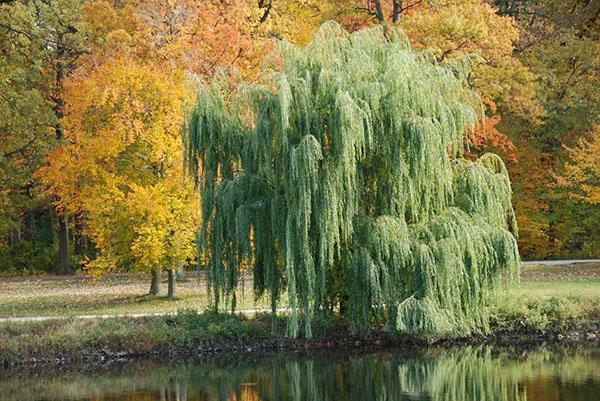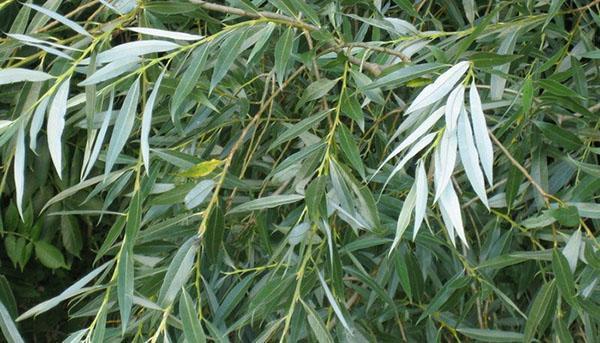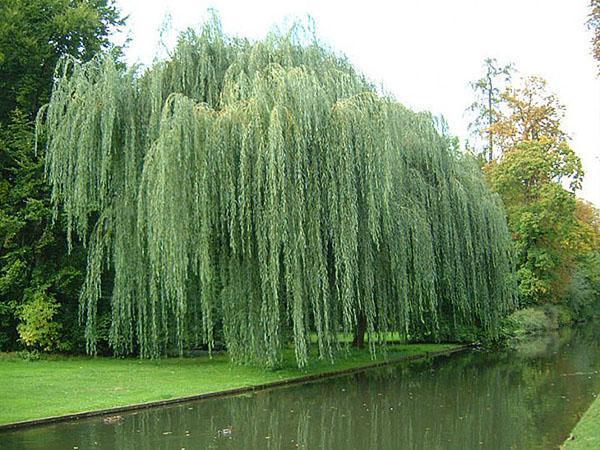Unpretentious, useful and effective white willow
 This tree of the Willow family is widely known as white or silver willow, willow, willow and willow. It prefers moist, damp places and grows along the banks of rivers, ponds and bodies of water. Willows often form entire groves that stretch along the water's edge for considerable distances. Thanks to their well-branched root system, trees are used to strengthen the banks of water bodies and ravines.
This tree of the Willow family is widely known as white or silver willow, willow, willow and willow. It prefers moist, damp places and grows along the banks of rivers, ponds and bodies of water. Willows often form entire groves that stretch along the water's edge for considerable distances. Thanks to their well-branched root system, trees are used to strengthen the banks of water bodies and ravines.
White willow can be described as a large dioecious tree with a large crown, which grows up to 20-30 meters in height. This distinguishes it from other species of the family, most of which are shrubs. Willow is light-requiring, frost-resistant and not too demanding on soils. She prefers sandy or sandy-silty moist soil, tolerates urban conditions well and can live up to 100 years.
The crown of the white willow is spreading, tent-shaped. The trunk is powerful, covered with cracked dark gray bark. Leaves are simple, petiolate, with stipules. 
Reproduction, cultivation and care
 The tree can multiply by seeds, but since they quickly lose their germination, this method is practically not used for breeding. White willow grows rarely, therefore, vegetative propagation is used with stem cuttings, which are cut before bud break. The cuttings take root quickly. Beforehand, they can be placed in water to form roots, and then planted in the ground.
The tree can multiply by seeds, but since they quickly lose their germination, this method is practically not used for breeding. White willow grows rarely, therefore, vegetative propagation is used with stem cuttings, which are cut before bud break. The cuttings take root quickly. Beforehand, they can be placed in water to form roots, and then planted in the ground.
When planting, for each seedling, prepare small pits measuring 0.5x0.5 m, which need to be filled with a mixture of soil, peat, compost and manure... Choose a sunny, well-lit place. Young seedlings need watering, fertilizing with mineral fertilizers and crown formation.
The healing properties of white willow
 This tree is widely known in folk medicine. White willow bark is used as a medicinal raw material, the medicinal properties of which are due to the content of such substances:
This tree is widely known in folk medicine. White willow bark is used as a medicinal raw material, the medicinal properties of which are due to the content of such substances:
- vitamin C;
- flavones;
- lignin;
- catechins;
- anthocyanins;
- glycoside salicin;
- tannins.
The bark of the white willow is harvested from March to May, when the sap flow is slow and it separates well from the branches. For harvesting, shoots are used at the age of 2-3 to 6-7 years. The bark is then dried until it becomes brittle. The medicinal raw materials prepared in this way can be stored and used for 4 years.
A decoction of willow bark is used as an antipyretic agent for fever, rheumatism, inflammation of the mucous membranes of the stomach and intestines. It has disinfecting, astringent properties and is used as an anti-inflammatory agent for stomatitis, gingivitis, catarrh of the upper respiratory tract, tonsillitis and acute respiratory infections.
 The broth has hemostatic, diuretic and choleretic qualities. Externally, it is used to rinse the throat and mouth, it is used for foot baths for sweating, skin diseases and varicose veins... The medicinal properties of white willow can also be used as a hemostatic agent from its bark.
The broth has hemostatic, diuretic and choleretic qualities. Externally, it is used to rinse the throat and mouth, it is used for foot baths for sweating, skin diseases and varicose veins... The medicinal properties of white willow can also be used as a hemostatic agent from its bark.
The use of white willow bark in traditional medicine
 To prepare a decoction of 1 tbsp.a spoonful of crushed raw materials should be poured into an enamel bowl with 200 ml of boiling water. Then stand in a water bath for 20 minutes, strain without waiting for cooling, and bring to the original volume with boiled water.
To prepare a decoction of 1 tbsp.a spoonful of crushed raw materials should be poured into an enamel bowl with 200 ml of boiling water. Then stand in a water bath for 20 minutes, strain without waiting for cooling, and bring to the original volume with boiled water.
For external use, in addition to the broth, you can prepare an infusion of willow bark. For this, a glass of dry crushed raw materials is poured with a liter of boiling water and insisted for 30 minutes. The resulting infusion is added to a basin of hot water intended for foot baths. This remedy not only relieves varicose veins, but is also effective against leg sweating.
A decoction of willow bark is used for hair loss. For its preparation 1 tbsp. a spoonful of chopped dry bark and 1 tbsp. a spoonful of burdock roots is poured into 0.5 liters of water and placed in a water bath for 20 minutes. After that, it is insisted for 2 hours and filtered. The ready-made broth is used to wash hair in case of hair loss.
Contraindications for use inside the bark of white willow are:
- Sensitivity to salicylates.
- Pregnancy and breastfeeding.
- Peptic ulcer of the stomach and duodenum.
- Allergic diseases and bronchial asthma.
It is not recommended to use this remedy for the treatment of children and adolescents under the age of 16. Another of the contraindications is the simultaneous use of drugs prescribed for colds, cough suppressants, amino acids, antacids, vitamins and aspirin.
The use of white willow in needlework
 Flexible rods of white weeping willow are used to make hedges and various handicrafts. This exciting activity is a common type of needlework. Baskets, trays, decor items and even furniture woven from willow rods will decorate the interior and bring a piece of living warmth and natural atmosphere into it.
Flexible rods of white weeping willow are used to make hedges and various handicrafts. This exciting activity is a common type of needlework. Baskets, trays, decor items and even furniture woven from willow rods will decorate the interior and bring a piece of living warmth and natural atmosphere into it.
For weaving, use annual and biennial willow shoots. They should be harvested in early spring, when growth has not yet begun, or in late autumn, when it has already stopped. The rods should be straight, flexible, resilient, without bark damage and with healthy wood.
Learning to weave simple products is not difficult, you just need to be patient and willow twigs. This tree will give you a passion for years to come, and the experience and skill you have gained can be used to craft more complex items such as furniture. Furniture wicker made of willow rods is beautiful, reliable, easy to maintain, and can serve for many years.
White willow in landscape design
 This unpretentious tree, which we also know as willow, rakita or willow white tristis, is used in ornamental gardening for landscaping parks and squares. Willow conditions are especially good where there are bodies of water, large or small. It is valued for its fairly fast growth and original crown shape. This makes it possible to successfully use the tree in the formation of the garden and park landscape.
This unpretentious tree, which we also know as willow, rakita or willow white tristis, is used in ornamental gardening for landscaping parks and squares. Willow conditions are especially good where there are bodies of water, large or small. It is valued for its fairly fast growth and original crown shape. This makes it possible to successfully use the tree in the formation of the garden and park landscape.
As you can see in the photo, the white willow has a spreading crown with hanging branches. It looks great both in single plantings and in landscape compositions. This tree will be a spectacular decoration of the site in the English style, which provides for asymmetry, free planning and maximum approximation to natural conditions.
Long before Christianity, our ancestors revered the white willow. Willow twigs were used as a remedy against the evil eye, and a broom made of them served as a kind of amulet in the house. Such importance was attached to this tree, since it was believed that the willow has great vitality, blooms first and takes pure spring energy from the sun earlier than other trees.